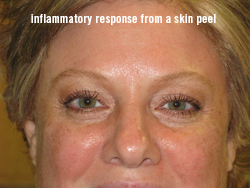
Inflammation is often associated with infections and wounds, and while this association does have some validity, it’s important to remember inflammation is not a synonym for either of those. Rather it is the response caused by infection or a wound – the body’s response to trauma, and in fact, it is a very complex biological process.
Inflammation tells the body to begin the healing process. Without inflammation, wounds and infections would not heal, in this regard it becomes an important and necessary part of skin rejuvenation. When inflammation becomes dangerous is in chronic situations. As skin care professionals, it’s important we understand the difference between acute and chronic inflammation, and how it impacts the aging and rejuvenation process.
Types of inflammation
Inflammation is the body’s way of responding to trauma and harmful stimuli such as pathogens and other irritants. It is a form of protection, aiding the body in removing the injury or irritant and stimulating the healing process.
There are two classifications of inflammation: acute and chronic. Acute is the aforementioned initial response by the body to initiate healing. Chronic is prolonged inflammation, which can often lead to a variety of diseases.
Acute inflammation generally lasts for several days or less and is essential to the healing process. This is simply the body’s way of sending internal support to the wound site by increasing the flow of plasma and leukocytes to eliminate pathogens. Swelling indicates the area is full of plasma and leukocytes, and pain draws awareness to the damage, prompting gentle care be taken. This is normal inflammation and a good thing.
Inflammation: the good and the bad
There are five principal signs of inflammation – pain, heat, redness, swelling and loss of function – all of which are essential to regenerating the skin. During the inflammation stage platelets release pro-youth growth factors to heal, rebuild and renew the area.
Certain aesthetic treatments trigger this acute inflammatory response. For example when performing a skin peel, the first sign of wounding is an inflammatory response, which also kick-starts the rejuvenation process.
Inflammation has a number of stimuli including burns (this includes over exposure to the sun), stress, toxins, trauma, alcohol, immune reactions, infection by pathogens, foreign bodies such as dirt and debris, and the list goes on.
Inflammation only becomes problematic when it is chronic. When it is a constant part of your physiology, serious issues may occur such as cancer, rheumatoid arthritis, atherosclerosis, hypersensitivities, autoimmune disease, chronic acne, etc.
Taming inflammation
To support the skin in its healing process when inflammation occurs, skin care ingredients such as arnica (Arnica Therapy), omega 6 essential fatty acids (linoleic and oleic acid), algae extract (Sea Gems), epidermal growth factors (Growth Factor Serum), bisabolol (Calming Skin Gel), and antioxidants are just a few that may be used to help ease pain, redness and swelling, as well as stimulate cell regeneration.
In regard to skin, inflammation is also a major contributor to aging. This may be brought on by many factors, however free radicals, which cause inflammation, are primary culprits. Inflammation caused by free radicals induces degradation of cells and reduction of collagen production. Overtime this inhibits the body’s ability to naturally repair the area, which in turn causes visual signs of aging.
A big offender of constant inflammation, and aging, is the sun. Continually educate clients about the need for a good SPF 30 or higher. While not all causes of inflammation can be avoided, this one stimulus that is absolutely avoidable and will protect the skin from irreversible damage and disease.
Always keep in mind proper diagnosis is essential. If you are ever unsure of the cause, refer clients to a medical professional.
Question: What is your go-to tool for treating calming inflammation?
